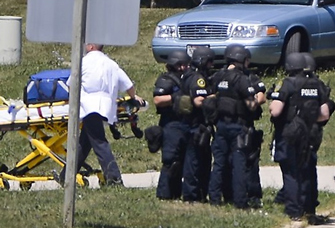Sikh Temple shooter formed White supremacist views in U.S. military
By Askia Muhammad -Senior Correspondent- | Last updated: Aug 15, 2012 - 9:20:58 AMWhat's your opinion on this article?

Jas Kaur cries during a memorial at the Sikh Religious Society of Wisconsin. Photo: MGNOnline/James Keivom
|
Army veteran Wade Michael Page attacked the Oak Creek Sikh Temple with a 9 mm pistol shortly before Sunday services were due to begin. Mr. Page killed five men and one woman, and injured two other men, authorities said. He then ambushed the first police officer who responded, shooting him nine times and leaving him in critical condition. A second officer then shot Mr. Page in the stomach from about 75 feet away, and authorities insist Mr. Page took his own life with a shot to the head.

Wade Michael Page
|
The Sikh “appearance,”—turban, beard, for example—has often been mistaken by racists for what resembles the common, stereotypic Islamic appearance. Since Sept. 11, 2001 Sikhs in this country have been frequent victims of attacks by attackers who taunt them, calling them “terrorists.”
On Aug. 6, one day after the Wisconsin Sikh massacre, the mosque in Joplin, Missouri, was burned to the ground. This came one month after an arsonist attacked the same Islamic center, starting a small fire on its roof.
The Islamic Society of Joplin was torched at about 3:30 a.m. Aug. 6 according to the Jasper County Sheriff’s Office. The building was a total loss. There were no injuries and no charges were filed.
Wisconsin temple gunman Wade Michael Page may have come by his racist views in a surprising place—the U.S. military. Now, Mr. Page is being compared with Oklahoma City bomber Timothy McVeigh, also an army veteran. When Mr. Page arrived in 1995 at the Army’s Fort Bragg in North Carolina, the base was already home to a small number of White supremacists including three soldiers later convicted in the murder of a Black couple according to TalkingPointsMemo.com.
“Outside every major military installation, you will have at least two or three active neo-Nazi organizations actively trying to recruit on-duty personnel,” T.J. Leyden, a former White power skinhead in the U.S. Marines who now conducts anti-extremism training told TPM.
Mr. Page had ties to White supremacist groups and the FBI acknowledges it knew of him, though no formal investigation ever took place. That attitude is typical of the prevailing view of law enforcement agencies for White supremacists. “During the War on Terror, even the thin regulations (barring White supremacists recruits into the U.S. armed forces) that did exist were completely jettisoned,” said Matt Kennard, author of the forthcoming book, “Irregular Army: How the U.S. Military Recruited neo-Nazis, Gang Members, and Criminals to Fight the War on Terror.”

Police tactical squad offi cers gather after a shooting at a Sikh temple in Oak Creek, Wisconsin. Photo: MGNOnline/EPA
|
His military experience had a profound affect on Mr. Page, according to Pete Simi, a University of Nebraska criminologist who knew Mr. Page. The Fort Bragg experience helped instill Mr. Page’s allegiance to the White Power movement.
“What he told me during the course of our time together was that he really started to identify with the neo-Nazism during his time in the military,” Mr. Simi, who met Page in 2001 while doing a study on White power groups in California, told CNN. “And specifically, what he told me at one point was that, if you join the military and you’re not a racist, then you certainly will be by the time you leave.”
In particular, Mr. Simi said, Mr. Page’s military experience bolstered his perception that “the deck was stacked against whites.”
“He came to feel that there was preferential treatment for African-Americans in the military and Whites were always on the short end of the stick,” Mr. Simi continued. “And the more he got into the Nazi ideology, the more he came to see all of society in that way.” Mr. Simi is the author of “American Swastika: Inside the White Power Movement’s Hidden Spaces of Hate.”
After a tragedy like the Oak Creek massacre, the U.S. military is usually embarrassed by the media reaction and questions from the public asking why is this country arming right-wing extremists, Mr. Kennard explained
“So, the Army is on the back foot, and then they say, we have tightened the regulation. But, in reality, there is nothing proactive about it. In fact, I heard from extremist veterans themselves that their command would send them on the hardest missions because, obviously, neo-Nazis, and gang members as well—which was a big problem, which is worth mentioning as well—that they are seen more as war-like,” said Mr. Kennard.
Other soldiers in the 82nd Airborne Division stationed at Fort Bragg were arrested in connection with the murder of a Black couple in nearby Fayetteville. Investigators found neo-Nazi materials in the barracks of the men, and all three were eventually convicted. The case prompted a military review that determined 22 soldiers at the base had past or present links to skinhead groups, though investigators concluded there was no organized extremist movement operating among the more than 14,000 troops of the 82nd Airborne at the time.
But those who served with Mr. Page at that time say he showed racist tendencies then. “He was involved with White supremacy. He talked about the racial holy war a lot,” said Chris Robillard, who met Mr. Page at Fort Bragg in 1995 when both were doing psychological operations training he said.
INSIDE STORIES AND REVIEWS
-
-
About Harriett ... and the Negro Hollywood Road Show
By Rabiah Muhammad, Guest Columnist » Full Story -
Skepticism greets Jay-Z, NFL talk of inspiring change
By Bryan 18X Crawford and Richard B. Muhammad The Final Call Newspaper @TheFinalCall » Full Story -
The painful problem of Black girls and suicide
By Charlene Muhammad -National Correspondent- » Full Story -
Exploitation of Innocence - Report: Perceptions, policies hurting Black girls
By Charlene Muhammad -National Correspondent- » Full Story -
Big Ballin: Big ideas fuel a father’s Big Baller Brand and brash business sense
By Bryan Crawford -Contributing Writer- » Full Story






 Click Here Stay Connected!
Click Here Stay Connected!








